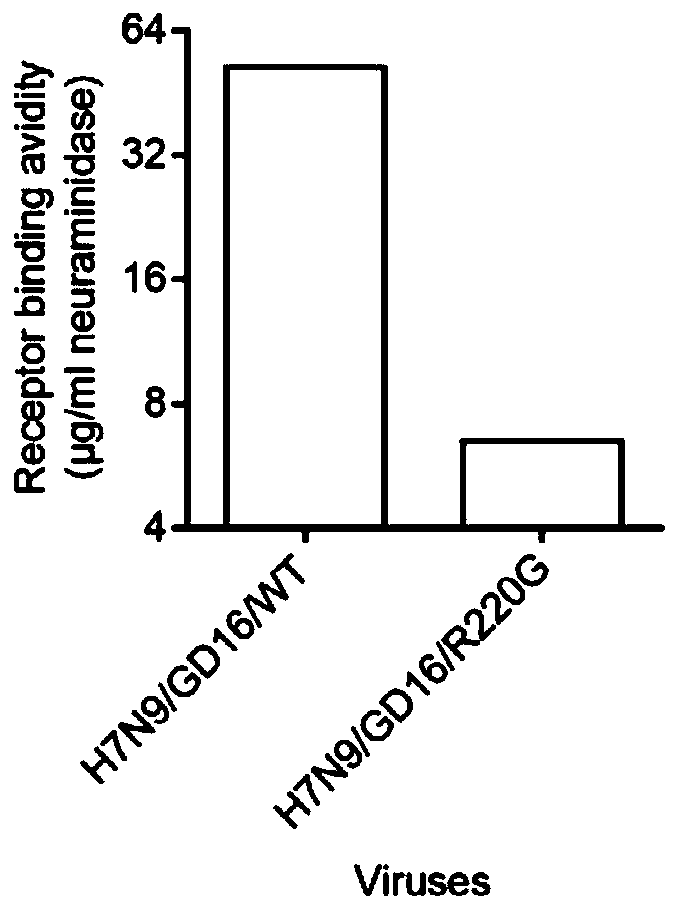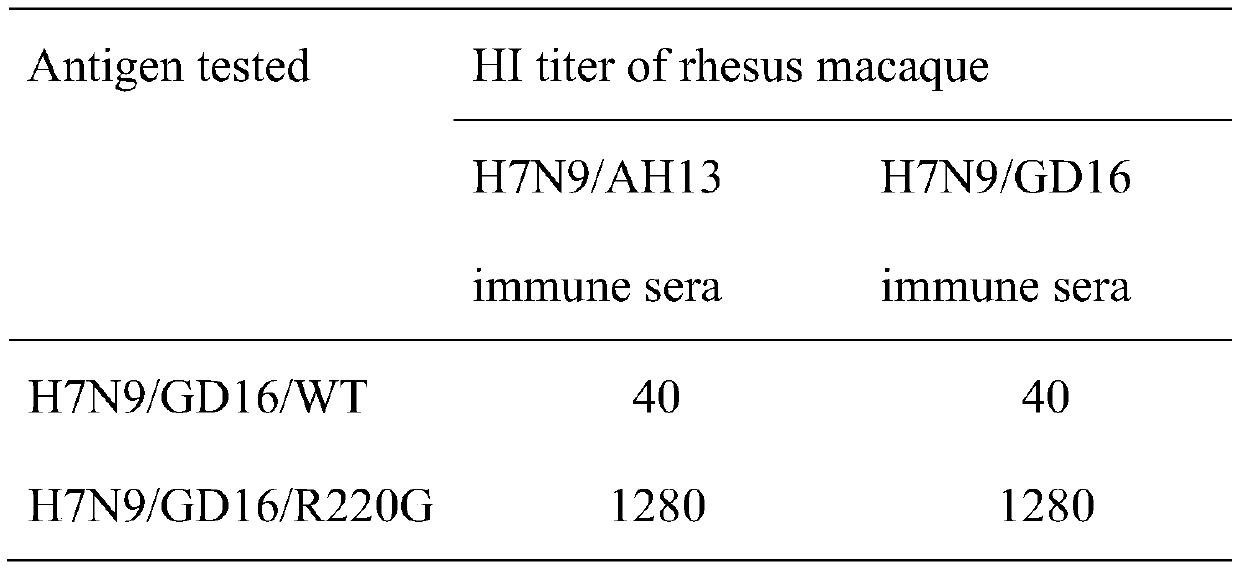High-pathogenicity H7N9 avian influenza virus antigen with low receptor binding activity and preparation method of antigen
An avian influenza virus, highly pathogenic technology, applied in the field of virus genetic engineering, can solve the problems of the influence of receptor affinity results, low receptor binding activity, etc., and achieve the effect of improving biological safety
- Summary
- Abstract
- Description
- Claims
- Application Information
AI Technical Summary
Problems solved by technology
Method used
Image
Examples
Embodiment 1
[0036] Method for Reducing HPAI H7N9 Influenza Virus Receptor Binding Affinity
[0037] The first step is to synthesize the HA gene: first, according to the HA gene sequence of the HPAI H7N9 influenza vaccine strain A / Guangdong / 17SF003 / 2016 (H7N9) recommended by WHO, synthesize the HA gene with multiple basic amino acid deletions at the cleavage site, the cleavage site The HA gene (called H7 / GD16 / WT) with multiple basic amino acid deletions was completed by GenScript. Existing studies have shown that the cleavage site with multiple basic amino acids is a sign of highly pathogenic avian influenza virus, and the deletion of multiple basic amino acids can reduce its pathogenicity, so that the recombinant virus can be tested in the biosafety level two experiment. The operation is carried out in the room without affecting the immunogenicity of the HA protein. For the sake of safety, the cleavage site in the HA gene of the HPAI H7N9 influenza vaccine strain, which has the character...
Embodiment 2
[0052] The difference between Example 2 and Example 1 is that the NA fragment in Example 2 is selected from N9NA gene with non-oseltamivir resistance mutation. The NA gene containing the oseltamivir resistance mutation has the effect of resistance to oseltamivir, and the HPAI H7N9 influenza virus prepared by using this mutated NA gene has the risk of drug-resistant gene proliferation. By using non-oseltamivir The drug-resistant mutated NA gene can prevent the oseltamivir drug-resistant mutated NA gene from spreading influenza virus widely. The synthesis of HA gene of H7 / GD16 / WT, the construction of pM-H7 / GD16 / WT recombinant plasmid and the site-directed mutation of HA gene in Example 2 are all the same as in Example 1 above.
[0053] In the first step, the NA gene of the LPAI H7N9 vaccine strain A / Anhui / 1 / 2013 (H7N9) (GISAIDID: EPI439509, called N9 / AH13) was selected as the NA gene. N9 / AH13 was completed by GenScript, and N9 / AH13 The sequence of is shown in SEQ ID NO.7.
[0...
Embodiment 3
[0066] A method for the preparation of HPAI H7N9 influenza virus with low receptor binding affinity comprising an inactivation step.
[0067] The first step, inactivation of influenza virus
[0068] The recombinant influenza virus prepared in the above-mentioned Example 2 was inactivated, and the specific inactivation method was as follows. Formaldehyde solution was used for inactivation, and formaldehyde solution with a final concentration of 0.1% was added to the virus allantoic fluid, and inactivated at 37° C. for 16 hours. The inactivated influenza virus was continuously passaged in chicken embryos for three times, and it was determined that the inactivation was successful if no hemagglutination titer was detected after passage.
[0069] The inactivated and purified H7N9 / GD16 / WT and H7N9 / GD16 / R220G recombinant viruses were recorded as two HPAI H7N9 influenza viruses, which were HPAI H7N9 influenza virus HI detection antigens.
PUM
 Login to View More
Login to View More Abstract
Description
Claims
Application Information
 Login to View More
Login to View More - R&D Engineer
- R&D Manager
- IP Professional
- Industry Leading Data Capabilities
- Powerful AI technology
- Patent DNA Extraction
Browse by: Latest US Patents, China's latest patents, Technical Efficacy Thesaurus, Application Domain, Technology Topic, Popular Technical Reports.
© 2024 PatSnap. All rights reserved.Legal|Privacy policy|Modern Slavery Act Transparency Statement|Sitemap|About US| Contact US: help@patsnap.com










